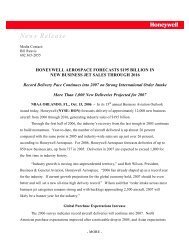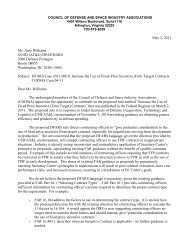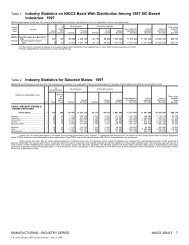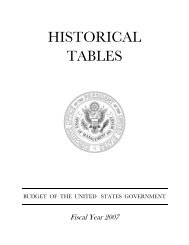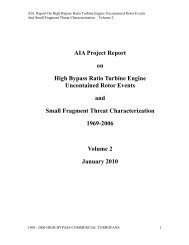AIA Executive Report - Aerospace Industries Association
AIA Executive Report - Aerospace Industries Association
AIA Executive Report - Aerospace Industries Association
You also want an ePaper? Increase the reach of your titles
YUMPU automatically turns print PDFs into web optimized ePapers that Google loves.
<strong>AIA</strong> What are the key challenges associated with implementing biofuels in aviation<br />
Yonkers We may find there are some challenges in acculturation – even though the pilot who flew the A-10<br />
didn’t blink. Before these fuels are put into an aircraft they are tested in engines under any number of<br />
conditions. And then they are tested on the aircraft. We want to make sure the performance and safety<br />
aspects are there. It may take a little acculturation with pilots across the Air Force, but my sense is that<br />
they have a lot of faith that it has been tested on aircraft before it goes into use in the fleet.<br />
<strong>AIA</strong> What are the climate-impact implications of biofuels<br />
Yonkers If it isn’t greener than conventional fuels, we’re not going to use it. It has to reduce carbon emissions.<br />
Biofuels, by their nature, should be cleaner than the synthetic fuels. We want to be able to find domestic<br />
alternative sources of fuel that are equal to or better than JP-8 as far as cost effectiveness comparisons<br />
and performance. We’re not going to spend more money than we do on fossil fuels. We want to be able<br />
to fly all aircraft on these synthetic and biofuels as part of our energy and national security strategies.<br />
<strong>AIA</strong> Which alternative fuels seem to be the most promising<br />
Yonkers We’d leave this up to industry to decide. There’s research into a number of feedstocks and we’re<br />
feedstock agnostic. Our message to the industry is that if you can make this work and hit the military<br />
fuel specifications, and beat the lifecycle greenhouse gas emissions of traditional petroleum fuels, we’re<br />
not going to pick a favorite.<br />
<strong>AIA</strong> How much of such biofuel might be feasible to purchase<br />
Yonkers We’re looking at about 300 million gallons of alternatively-derived fuel on an annual basis. That’s what<br />
we would be ready to use if industry can produce it. And our goal is to be there by 2016. We will certify<br />
the aircraft to fly on these fuels between 2011 and 2013.<br />
<strong>AIA</strong> So the Air Force feels a sense of mission regarding alternative fuels<br />
Yonkers When the administration talks about taking a leadership role, this is it. We won’t be the market drivers<br />
necessarily, but hopefully we will send out positive demand signals to the private sector that we are<br />
ready to buy. This is going to be a path, not an instant result. The market is going to react depending<br />
on what the demand signals are. This is all linked with national security, energy security and economic<br />
security policies – and this is one element of trying to achieve the president’s goals.<br />
<br />
ANDREWS AIR FORCE BASE, Md. (March 31, 2010) President Barack Obama, with the Navy’s F/A-18 Green Hornet, announces additional<br />
measures to boost domestic energy production for the nation to include strategic efforts by the Defense Department to enhance energy security. The<br />
Navy’s goal is to develop the certification standards for alternative fuel sources derived from renewable sources that are positive or evironmentally<br />
neutral and improve availiability and price stability.<br />
U.S. Navy photo by Mass Communication Specialist 2nd Class Kevin S. O’Brien/Released<br />
executive report 5




